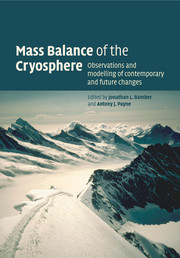Book contents
- Frontmatter
- Contents
- List of contributors
- Foreword
- Preface
- 1 Introduction and background
- Part I Observational techniques and methods
- Part II Modelling techniques and methods
- Part III The mass balance of sea ice
- 8 Sea-ice observations
- 9 Sea-ice modelling
- Part IV The mass balance of the ice sheets
- Part V The mass balance of ice caps and glaciers
- Index
- References
9 - Sea-ice modelling
Published online by Cambridge University Press: 16 October 2009
- Frontmatter
- Contents
- List of contributors
- Foreword
- Preface
- 1 Introduction and background
- Part I Observational techniques and methods
- Part II Modelling techniques and methods
- Part III The mass balance of sea ice
- 8 Sea-ice observations
- 9 Sea-ice modelling
- Part IV The mass balance of the ice sheets
- Part V The mass balance of ice caps and glaciers
- Index
- References
Summary
Representing the mass balance of sea ice involves solving a coupled, non-linear set of equations describing ice motion (momentum balance), thermodynamic growth and melt (energy balance) and the transport and redistribution of ice thickness (area and volume conservation). A detailed description of the theory underlying sea-ice models is provided in Chapter 7, and so only a brief review is provided here. It is the case that approximations employed to represent many important processes, both in stand-alone ice models and in more comprehensive global climate models, lead to errors or uncertainties in simulated sea-ice behaviour. Nonetheless, because of the scarcity of direct observations related to sea-ice mass balance, models provide valuable insight into the mean state of the ice cover and its historical and projected future changes.
Brief overview of sea-ice models
The sea-ice mass balance involves local growth and melt, horizontal transport and deformation. These processes alter the local mean thickness (ice volume per unit area) and involve exchanges of mass (fresh water) and energy with the atmosphere and ocean. Figure 9.1 provides an illustration, for the Arctic, based on results of a stand-alone sea-ice model (Hilmer, Harder and Lemke, 1998). In this figure the annual mean ice transport is indicated by the vectors, the annual mean ice thickness by the solid contours and the net freezing rate (net ice growth minus ice melt – directly proportional to the salt flux delivered to the ocean surface) by the coloured shading.
- Type
- Chapter
- Information
- Mass Balance of the CryosphereObservations and Modelling of Contemporary and Future Changes, pp. 367 - 390Publisher: Cambridge University PressPrint publication year: 2004
References
- 9
- Cited by



